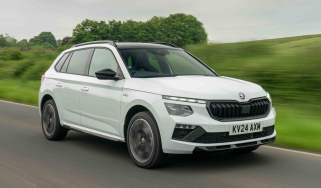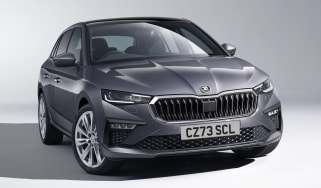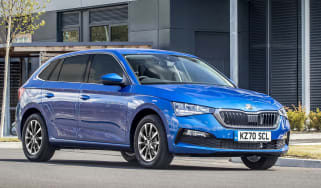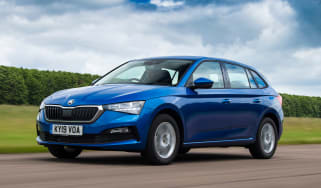Skoda Scala review
Skoda’s family hatch offers a class-leading combination of space, quality, comfort and value

Is the Skoda Scala a good car?
For family car buyers looking for value, the Skoda Scala is a great choice. It’s also one of the most practical cars in its class, offering a huge boot and lots of passenger space. It also gives the Volkswagen Golf a run for its money when it comes to ride, handling and build quality. Standard equipment is good across the range too, as is the fuel economy offered by the Scala's range of petrol engines.
Value is what impresses most with the Scala, though – all of this ability comes at a price that undercuts every version of the Golf and matches most of its nearest rivals. It’s hard to recommend the Volkswagen Golf over the Skoda Scala unless you really want a little extra quality, polish and prestige; the Scala is so good it’s more than just a viable alternative.
| Key specs | |
| Fuel type | Petrol |
| Body style | Family hatchback |
| Powertrain | 1.0-litre, 3cyl, turbocharged petrol, front-wheel drive 1.5-litre, 4cyl, turbocharged petrol, front-wheel drive |
| Safety | 5-stars (Euro NCAP, 2019) |
| Warranty | 3yrs/60,000 miles |
How much does the Skoda Scala cost?
Whichever trim level you choose on a Skoda Scala, it’ll offer impressive value for money versus its nearest rivals, with prices starting at under £22,500 for an entry-level SE Edition. The mid-range SE L Edition is a little more at just over £24,000, while the top-of-the-range Monte Carlo Edition begins at a little under £28,000.
While the Skoda Octavia features a saloon-like body (albeit with a large hatchback), the Scala takes a more practical shape that allows for lots of boot and passenger space. The Scala is built on the Volkswagen Group's MQB A0 platform – the same one that underpins the VW Polo, Audi A1 and SEAT Arona – and all its engines are familiar Volkswagen Group units, too.
Used - available now

2020 Skoda
Scala
69,461 milesAutomaticPetrol1.0L
Cash £10,600
2023 Skoda
Scala
34,578 milesManualPetrol1.0L
Cash £11,000
2023 Skoda
Scala
20,161 milesManualPetrol1.0L
Cash £13,723
2023 Skoda
Scala
37,300 milesManualPetrol1.0L
Cash £12,000Buyers are given the choice of a 1.0-litre TSI petrol producing either 94bhp or 114bhp, and a 1.5-litre TSI engine producing 148bhp. The 94bhp petrol unit is offered with a five-speed manual gearbox, while all other versions come with either a six-speed manual, or a seven-speed DSG automatic transmission.
The Scala's trim structure consists of SE Edition, SE L Edition and top-spec Monte Carlo Edition models. Base SE Edition cars come with LED headlights, 16-inch alloy wheels, a 10.25-inch Virtual Cockpit digital instrument display, an 9.2-inch central touchscreen with sat-nav, dual-zone climate control, wireless Apple CarPlay and Android Auto connectivity, cruise control and rear parking sensors with a reversing camera.
SE L Edition versions feature 17-inch alloys, front parking sensors, rear privacy glass, heated front seats, and automatic lights and wipers. Finally, top-of-the-range Monte Carlo Edition models get matrix LED headlights, black exterior trim, a panoramic glass roof, adaptive cruise control, wireless phone charging, and a rear-view camera.
Engines, performance & drive
The Skoda Scala occupies the same class as fellow MQB-platformed Volkswagen Group cars like the SEAT Leon, Skoda Octavia and Volkswagen Golf, but is actually built on the company’s smaller MQB A0 platform – the same one that underpins the VW Polo, Audi A1 and SEAT Arona. Like the other cars it shares a platform with, the Scala uses torsion-beam rear suspension. This setup costs less to make and doesn’t impact rear boot space compared with more complex multi-link systems. Plus, cheaper versions of the Leon, Octavia and Golf use a similar setup anyway.
| Model | Power | 0-62mph | Top speed |
| Scala 1.0 TSI 95 | 94bhp | 10.8seconds | 119mph |
| Scala 1.0 TSI 116 | 114bhp | 9.5seconds | 126mph |
| Scala 1.5 TSI 150 | 148bhp | 8.2seconds | 137mph |
What is the Skoda Scala like to drive?
In town
The ride on the examples we’ve tried with 17-inch wheels can send shudders through to the interior when going over bigger pot holes, but it generally copes well with urban speed bumps. The ride with smaller 16-inch wheels fitted to entry-level SE Edition soaks up the bumps even better.
The Scala is easy to drive with light steering to help when manoeuvring into a tight car parking space. Good all-round visibility should mean you won’t have to rely as heavily on the standard-fit rear parking sensors and reversing camera as you do in the Mazda 3.
You may need to call on the slick manual gearbox quite often in the entry-level 94bhp 1.0-litre petrol, because it has just enough pace to keep up with traffic, but don’t expect to be winning the traffic light Grand Prix with it.
On A- and B-roads
The Scala’s suspension, when specced with 16-inch wheels, is very well judged at higher speeds and rides just as well as an equivalent Volkswagen Golf. The suspension makes a bit more noise over bumps than its German counterpart, but it provides an impressively comfortable ride for a car of this price.
It also provides greater control of body movements over undulating roads or during cornering than the softer Citroen C4. The springs and dampers of the Scala can even handle a mid-corner bump without losing its composure like its C4 rival, helping the Scala to feel stable and sure-footed at higher speeds.
The light steering of the Scala feels precise enough for what most family hatchback buyers require. Those looking for more fun behind the wheel will be better served by the Ford Focus or Mazda 3, although you will have to pay more for that privilege.
We recommend upgrading to the more potent 114bhp 1.0-litre petrol compared with the 94bhp version, because the former has the extra performance needed to cope with a car load of people without having to work the engine or gearbox hard.
On the motorway
Stability is excellent at higher speeds, and refinement is up to the class standards. Following on from our earlier advice, we’d recommend going for the 114bhp 1.0-litre because it comes with a six-speed manual rather than the five-speed of the 94bhp version. That extra gear helps keep the revs down and further improve refinement.
The more potent 148bhp 1.5 has little trouble getting up to speed when merging onto a busy motorway and is flexible enough to pass slower-moving lorries without having to change down a gear.
Engines, 0-60 acceleration and top speed
The Skoda Scala has a fairly basic engine line-up made of two petrols, although the smallest 1.0-litre is available in two different power outputs: 94bhp or 114bhp. If you want the most powerful Scala, there’s the 1.5-litre with 148bhp.
The lower-powered 1.0-litre version needs a lengthy 10.8 seconds to reach 62mph from a standstill and is only offered with a five-speed manual gearbox. The more potent 114bhp variant manages 0-62mph in 9.5 seconds, has a 126mph top speed, and comes with a choice of a six-speed manual or seven-speed DSG automatic. The 1.5-litre improves on those figures with an 8.2-second 0-62mph time and a 137mph top speed in both manual and automatic forms.
Despite the punchier performance of the 1.5-litre petrol, we recommend the cheaper, yet still excellent 114bhp 1.0-litre TSI for most buyers. Performance is adequate for most everyday situations thanks to the engine’s decent torque and the Scala’s relatively lightweight.
MPG, emissions & running costs
The Scala’s light weight helps to make it one of the most efficient cars in its class – our preferred 114bhp 1.0-litre TSI model returns a combined WLTP figure of 54.9mpg if you stick with the standard six-speed manual gearbox, or 50.2mpg when equipped with the seven-speed DSG automatic.
The lower-powered 94bhp uses the same 1.0-litre TSI petrol engine to deliver up to 54.8mpg, while customers opting for the punchier 1.5-litre TSI model in top-spec Scalas will see economy fall slightly to around 51.9mpg. However, we averaged 41mpg in our Scala 1.5 TSI long-term test car during our 11,000 miles with it.
We managed a respectable 47.2mpg from the entry-level 94bhp petrol when we tested the Skoda Scala against the Citroen C4.
| Model | MPG | CO2 | Insurance group |
| Scala 1.0 TSI 95 SE Edition | 54.8mpg | 117g/km | 12E |
| Scala 1.0 TSI 116 SE Edition | 54.9mpg | 116g/km | 15E |
| Scala 1.5 TSI 150 Monte Carlo Edition | 50.6mpg | 126g/km | 21E |
Tax
Emissions for the 1.0-litre models range from 117g/km for the 94bhp model, to 127g/km for a DSG automatic 114bhp version. The 1.5-litre variant only emits 124g/km for both the manual and DSG auto models.
That being said, company car drivers will be better off with a hybrid car like the Toyota Corolla, which uses an electric motor to boost the efficiency of its petrol engine to get over 60mpg, and emits only 100g/km, giving it a lower Benefit-in-Kind (BiK) tax bill. There are also all-electric alternatives, such as the Peugeot E-308 and Vauxhall Astra Electric, which both benefit from reduced BiK costs and free road tax, at least until 2025.
Fortunately, the reasonable price of the Skoda Scala means that no version breaches the £40,000 threshold that would subject it to the luxury car tax.
Insurance groups
The Scala’s low running costs should extend to insurance too – the entry-level 94bhp model in SE Edition trim sits in group 12, while the more powerful 114bhp version occupies group 15 and the top-spec 1.5-litre petrol in Monte Carlo Edition trim is in group 21.
Depreciation
Our experts predict that the Skoda Scala will be competitive in the retained value stakes, holding on between 45 to 49 per cent of its original resale value come trade-in time after 36,000 miles and three years of ownership.
For comparison, the more expensive, premium-badged Volkswagen Golf is expected to retain 41 to 48 per cent of its value over the same period (excluding the high-performance R models), depending on the exact specification.
To get an accurate valuation for a specific model, check out our free car valuation tool...
Interior, design & technology
Form has followed function in most aspects of the Skoda Scala’s design – it’s a large hatchback for the class that doesn’t skimp on interior space by using a sloping roofline. The exterior looks sharp and modern, but rivals like the Mazda 3 do highlight the relatively plain design of the Scala. That’s not to say there aren’t some nice touches, such as the extended glass window of Monte Carlo models.
What is the Skoda Scala like inside?
Inside, the sensible no-frills approach continues with a dashboard that’s functional rather than overtly stylish.
It’s easy to find an acceptable driving position in the comfortable seats, and adjustable lumbar support is standard across the range. The cabin’s ergonomics are easy to get to grips with very quickly, and we appreciate that the brand has resisted the temptation to put frequently used features – such as the air-con temperature controls – into the infotainment screen as has been done on the Ford Focus. Much like the rest of the Scala’s agreeable traits, this further helps its case as a no-fuss, easy-to-own family car.
What is the interior quality like?
Everything is very well put together, though, with good quality materials and soft-touch plastics in all the right places – it easily stands in comparison with the Kia Ceed and Ford Focus, but it does lack the more premium feel you get with the Mazda 3.
Sat-nav, stereo and infotainment
All versions of Skoda Scala come with a 9.2-inch infotainment touchscreen, which includes wireless Apple CarPlay and Android Auto smartphone connectivity. The recent trim level changes have also seen all models benefiting from the smart-looking and intuitive-to-use 10.25-inch Virtual Cockpit digital instrument cluster and built-in sat-nav.
Skoda's infotainment system uses a neat user interface, and we found the touchscreen was quick to respond to our commands, plus the smartphone integration works well. The screen is sharp and looks modern, but we would prefer some more physical buttons to access menus more easily.
Boot space, comfort & practicality
The Skoda Scala majors on practicality – those looking to get the most space for their money will be hard pressed to find a better hatchback in the class. There are five seats, with those in the rear big enough for adults. Interior space is impressive generally – Skoda has done wonders with packaging. Visibility is great thanks to a large glasshouse.
The boot is large, and there’s the usual smattering of practical storage areas, including large door bins, a cooled glovebox, under-seat storage in the front, and a sunglasses cubby overhead. Other practical touches include electrically adjustable and heated mirrors, an auto-dimming rear-view mirror and a space-saver spare (rather than a rescue foam kit).
The Skoda Octavia is a good alternative if you need even more space, but the Scala’s shape makes it a more flexible proposition overall.
| Dimensions | |
| Length | 4,362mm |
| Width | 1,793mm (1,988mm inc mirrors) |
| Height | 1,474mm |
| Number of seats | 5 |
| Boot space | 467-1,410-litres |
Dimensions and size
The Scala measures 4,362mm long, 1,793mm wide (1,988mm including side mirrors) and 1,474mm tall. It’s about 510kg lighter than an equivalent Volkswagen Golf and over 130kg lighter than a Kia Ceed, despite being longer and more spacious inside than both.
How practical is the Skoda Scala?
Seats & space in the front
There’s loads of room for a pair of six-foot adults in the front, and the seats are very comfortable, with each getting height and lumbar adjustment as standard. A standard centre armrest also features, plus a leather-wrapped steering wheel.
A common trait of the Skoda brand is that its cars come with numerous thoughtful storage and convenience features, such as the umbrella in the driver’s door should you encounter a sudden downpour.
The front door bins are a useful size, as is the glovebox. There is space inside the centre armrest to store items out of sight, while three cupholders provide a place for various sizes of coffee cups or bottles of water. There’s a spot for your smartphone along with two USB-C charging ports ahead of the gearlever, but you’ll need to specify the £350 charging package or upgrade to Monte Carlo Edition in order to get wireless phone charging.
Seats & space in the back
There’s more space in the back of the Scala for passengers than just about any other car in this class – great news if you need space for a growing family. Speaking of which, ISOFIX points are supplied on the front passenger seat, and on the outer positions of the rear bench seat, with the securing rings easily accessed under some removable plastic caps. The rear doors open wide and, in combination with the relatively high roofline, offer good access to the rear when fitting child seats.
Boot space
One of the Scala’s big selling points is its even bigger boot – a wide, square load space with an impressive 467 litres and a low load lip. The boot is usefully bigger than the Volkswagen Golf’s 380-litre offering and beats the Ford Focus’ 375 litres of space.
The rear bench folds in a 60/40 split to increase total load capacity to 1,410 litres – a figure that’s among the very best in this class. The seats don’t fold completely flat, but it’s still a hugely practical space. The boot also features two large pockets behind each wheel arch – great for keeping loose items from sliding around.
If there’s one criticism, it’s that there’s a bit of a lip to lift items over when loading up the boot, so we’d suggest specifying an adjustable height boot floor for £200, because that removes the lip, and the awkward step when the rear seats are folded down, making the transport of longer items a bit easier.
Towing
The Scala can be prepared for – or fitted with – a tow bar as an option, but you’ll need to make sure the former box has been ticked on the list if you want to retrospectively add a tow bar. The 94bhp 1.0-litre TSI model can tow up to 1,000kg of braked trailer weight, while the 1.5 TSI manages a braked load of 1,250kg.
If you’re looking to tow more weight, consider the plug-in hybrid Vauxhall Astra with its 1,450kg braked towing limit, or a traditionally powered 2.0-litre diesel Golf, because that’ll pull up to 1,600kg.
Reliability & safety
Euro NCAP crash-tested the Skoda Scala in 2019 and awarded it a full five-star rating, with excellent scores for adult and child safety of 97 per cent and 87 per cent, respectively.
It’s encouraging to see a good amount of standard safety kit on the Scala, including autonomous emergency braking (AEB) called ‘Front Assist’, lane-keep assistance, traffic sign recognition, and an emergency call function. Some safety options are available, such as the £650 Safety Pack, which includes a driver’s knee airbag and rear side airbags. Adaptive cruise control isn’t standard, but you can add this with the Assisted drive pack for £800 on SE Edition or SE L Edition trims. A blindspot monitoring system to warn you of vehicles approaching along your side when driving down the motorway is a £500 option that comes as part of the Assisted Drive Plus Package that’s reserved for the Monte Carlo trim.
The Scala didn't feature in the 2024 Driver Power owner satisfaction survey, but it seems there’s work to do for the brand. The company finished in 23rd position out of 32 manufacturers included in the survey, behind ahead brands SEAT and Volkswagen in 24th and 29th place, respectively.
| Key standard safety features | Euro NCAP safety ratings |
|
|
Warranty
The Skoda Scala is covered by a three-year warranty with no mileage limits for the first two years, then up to 60,000 miles for the third year of ownership. It’s a competitive warranty, but it can’t match Hyundai’s five-year/unlimited-mileage coverage, nor Kia’s famous seven-year, 100,000-mile warranty. For just over £500 however, you can get an extended warranty to cover the Scala for up to five years or 100,00 miles, whichever comes first.
Servicing
All engines in the Skoda Scala range have service intervals every 12 months or 10,000 miles, whichever comes first. The timing belt will need to be changed every 112,000 miles. You can specify a service plan to cover your first two services when you purchase the car.
Skoda Scala alternatives
The Skoda Scala joined the Czech manufacturer’s range in 2019, sitting alongside the slightly larger Octavia in the hotly contested family car market as a more direct rival for the Volkswagen Golf, Ford Focus, Kia Ceed and Vauxhall Astra, among others.
There isn’t a hybrid or electric version of the Scala, unlike with its Peugeot 308, SEAT Leon, Toyota Corolla and Astra rivals. It's also worth noting that high-mileage drivers looking for the economy of a diesel engine will need to look elsewhere, because the 1.6-litre TDI diesel has been removed from the price list.
Skoda Scala 1.5 TSI SE DSG long-term test
In 2020, our photographer, Otis Clay, ran a Skoda Scala for six months, racking up over 6,000 miles. Otis found it to be a very practical family car that was perfectly capable of ferrying around all his camera equipment, with the more powerful 1.5-litre engine providing all the power he needed to get to and from shoots quickly and efficiently.
He did experience issues with the infotainment system (an older version that has since been replaced) crashing on him, and the DSG automatic gearbox was often slow to respond in town traffic, an issue that wasn’t helped by the Scala’s start/stop system. However, the latter could be easily turned off, making the car a little more responsive when pulling away at traffic lights.
Frequently Asked Questions
The Skoda Scala is one of our favourite family hatchbacks, as it offers fantastic value for money, lots of space and impressive fuel economy.



























